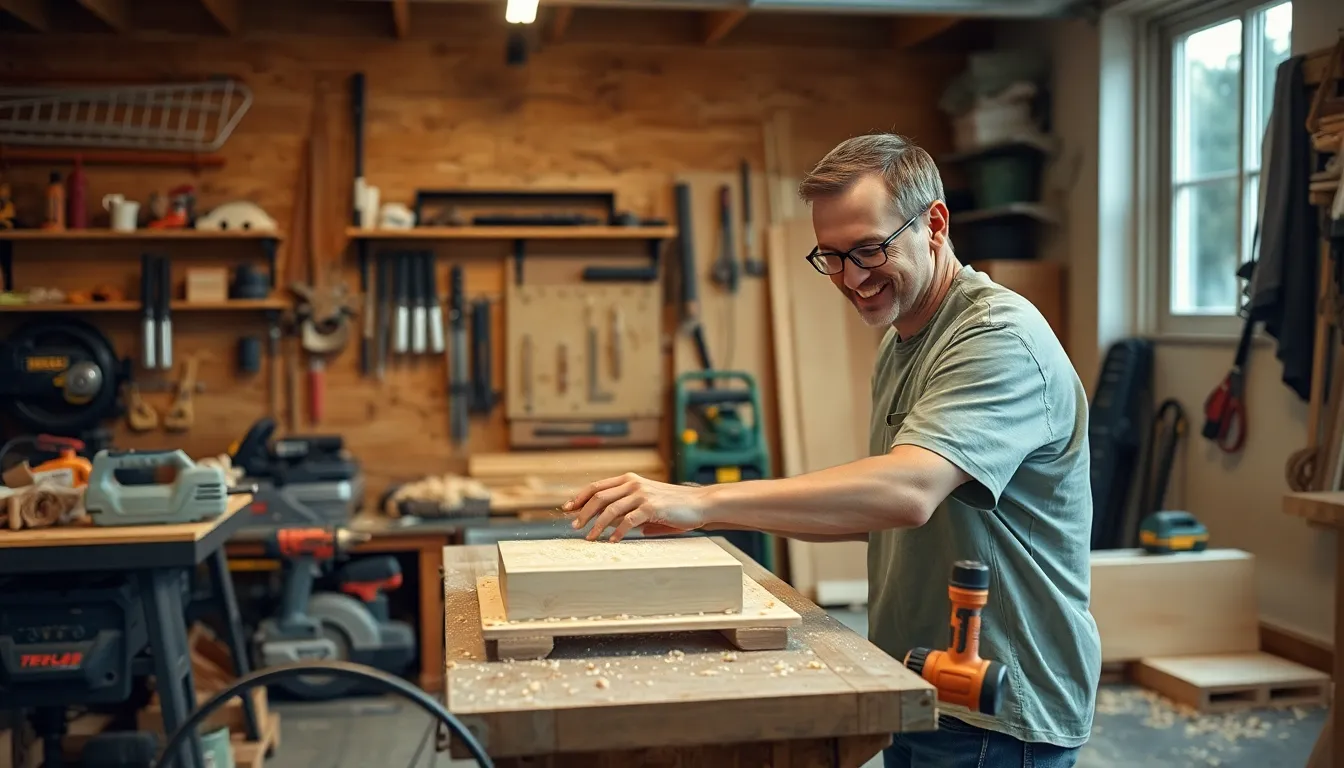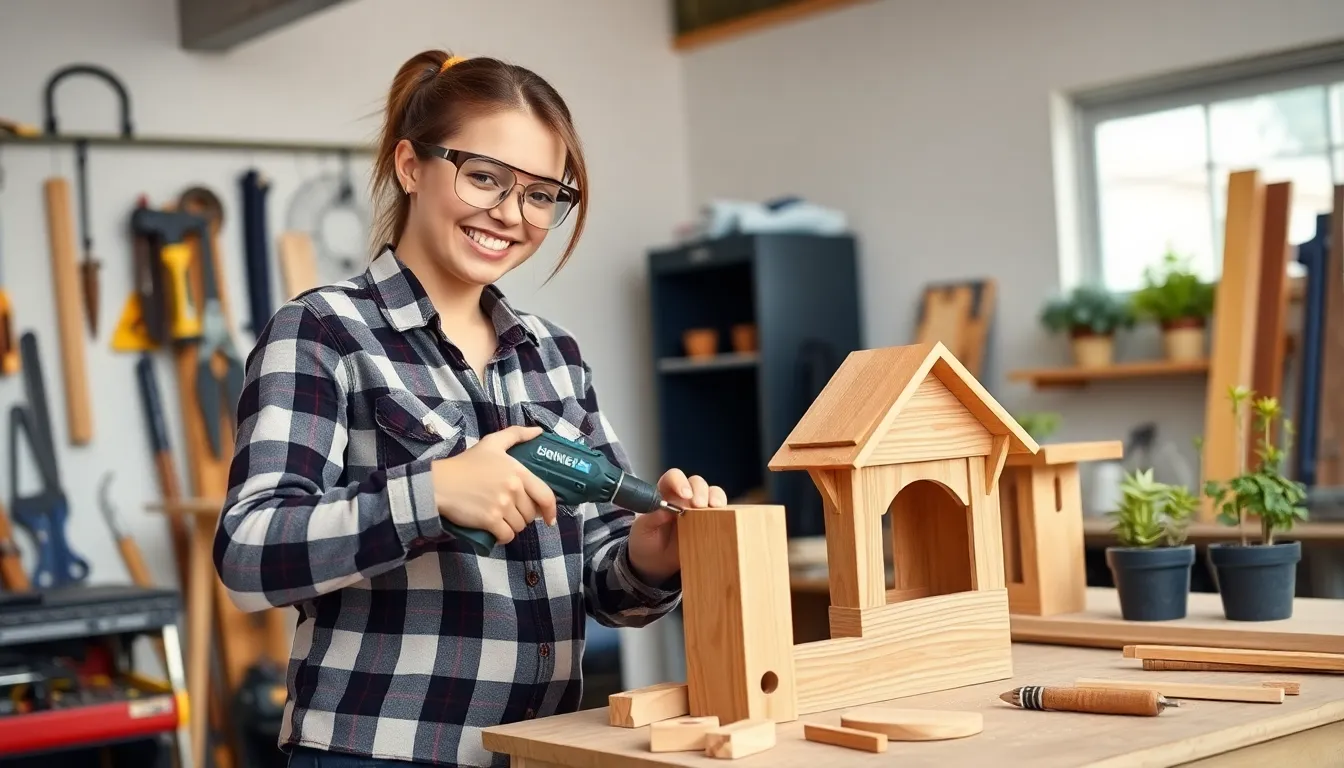Looking to unleash your inner carpenter without the need for a full workshop? Small DIY wood projects are the perfect solution! They’re like the appetizers of the woodworking world—quick to whip up and oh-so-satisfying. Whether it’s creating a chic wooden planter or crafting a quirky birdhouse, these projects promise a blend of creativity and functionality that’ll have your friends wondering if you’ve been secretly taking woodworking classes.
Table of Contents
ToggleOverview of Small DIY Wood Projects
Small DIY wood projects offer a practical entry point into woodworking. Each project functions as a simple, manageable task that requires minimal tools and materials. Makers can craft items such as wooden coasters, picture frames, or key holders in a short timeframe. Not only do these projects enhance skills, but they also foster creativity.
Tools involved often include a saw, drill, and sandpaper. Supplies like wood glue and finishing products complete the essentials for these tasks. Whether someone is a novice or has some experience, the satisfaction from creating functional pieces is immense.
Makers can customize projects to suit personal styles and preferences. For instance, they can choose various wood types, colors, and finishes to achieve distinct looks. Items like wooden planters provide practicality and aesthetic appeal for indoor or outdoor spaces.
Collaborative projects, such as building a simple bird feeder or decorative shelves, promote social interaction, making woodworking a shared hobby. Local workshops or community classes often provide support and resources, enhancing the learning experience.
Popular online resources include video tutorials and step-by-step guides. These platforms inspire individuals and provide clear instructions, ensuring a successful outcome. Ultimately, small DIY wood projects serve as a fulfilling way to explore woodworking while creating stunning, handmade items.
Benefits of DIY Wood Projects

Small DIY wood projects provide numerous benefits, appealing to both beginners and experienced makers. Participants can enjoy enhanced creativity and a sense of accomplishment with each completed task.
Cost-Effective Solutions
Cost savings emerge as a primary benefit of DIY wood projects. Materials often cost less than pre-made items, enabling makers to create custom pieces at a fraction of the price. Local home improvement stores usually offer affordable wood options. Using leftover materials from previous projects further reduces expenses. Makers can prioritize budget-friendly tools such as saws and drills that perform effectively without breaking the bank. Choosing simple projects ensures minimal material waste, keeping costs manageable and environmentally friendly.
Creative Expression
Creative expression flourishes through small DIY wood projects. Individuals can customize designs, dimensions, and finishes to reflect personal aesthetics. Options for different wood types and stain colors provide ample opportunities to experiment. Makers often find joy in transforming plain materials into unique pieces that tell their stories. Engaging in these projects encourages innovation and imagination. Friendships may flourish through collaborative efforts, as shared projects inspire new ideas and techniques. Ultimately, DIY wood projects serve as a canvas for artistic exploration and self-discovery.
Essential Tools and Materials
Small DIY wood projects require specific tools and materials to ensure successful outcomes. Understanding these essentials helps makers complete projects efficiently.
Basic Tools for Beginners
- Saws: Essential for cutting wood accurately, a handsaw or jigsaw suits various DIY projects.
- Drills: A cordless drill simplifies creating holes for screws and assembly.
- Sandpaper: Different grits locate and smooth surfaces, ensuring a polished finish.
- Wood Glue: Providing strong bonds, this adhesive secures joints effectively.
- Measuring Tape: Accurate measurements contribute to precise cutting and alignment.
These tools create a solid foundation for any maker, enhancing both skill development and creativity.
Wood Types for Projects
- Pine: This softwood is affordable, lightweight, and easy to work with, perfect for beginners.
- Cedar: Known for its resistance to moisture, cedar works well for outdoor projects like planters.
- Oak: A hardwood, oak offers durability and an attractive grain, ideal for furniture.
- Maple: This hardwood is dense and sturdy, suitable for detailed projects requiring precision.
- Plywood: Versatile and cost-effective, plywood provides stability for a range of applications.
Selecting the right wood type influences final project quality and aesthetic appeal, catering to various crafting styles.
Popular Small DIY Wood Projects
Small DIY wood projects provide creative outlets while enhancing practical skills. Numerous options exist for crafters, each offering unique benefits and aesthetic appeal.
Simple Shelves
Simple shelves often transform any room’s functionality and aesthetics. These projects require minimal materials and tools, making them suitable for beginners. Builders can use a single wood plank, brackets, and screws to create elegant floating shelves. Accurate measurements ensure stability and proper alignment. Different wood types, such as pine or oak, can enhance the overall look. Customizing stain or paint colors adds a personal touch. Installing shelves not only organizes space but also showcases decor and personal items effectively.
Decorative Picture Frames
Decorative picture frames present opportunities for creativity while preserving memories. Crafting frames only demands wood strips, glue, and basic tools like saws and sandpaper. Various designs exist, including rustic or modern styles, allowing flexibility in customization. Experimenting with wood finishes can match existing home decor. Builders can integrate intricate patterns or simple cuts according to individual preferences. Once completed, frames highlight cherished photographs in a visually appealing way, enhancing the aesthetic of any wall or tabletop.
Plant Stands
Plant stands create stylish displays for indoor or outdoor greenery. A sustainable project, they often utilize leftover wood scraps, reducing waste. Basic designs incorporate a few planks, joined together for stability. Choosing a configuration that suits plant size enhances both aesthetic and function. Decorative elements, such as paint or natural finishes, allow for personalization. Sturdy construction ensures that planters remain secure while showcasing vibrant plants. Crafting plant stands not only beautifies living spaces but also supports a thriving indoor garden.
Tips for Success in DIY Woodworking
Success in DIY woodworking comes with careful attention to detail and technique. Proper methods significantly enhance the quality of the finished project.
Measuring and Cutting Techniques
Accurate measurements serve as the foundation for any woodworking project. Use a tape measure to ensure precision when marking and cutting wood. Always double-check measurements before making cuts to avoid mistakes, which can waste materials. Observing wood grain direction helps achieve cleaner cuts, promoting smoother assembly. Saws, such as miter or circular saws, provide different cutting approaches; select one based on the project type. Employ a square to verify that edges remain straight, maintaining structural integrity throughout the build.
Finishing Touches
Finishing touches add the final flair to woodworking projects. Start with sandpaper to smooth rough edges and surfaces, enhancing both appearance and safety. Stain or paint options deliver a range of aesthetic choices, allowing for creativity in design. Apply finishes using brushes or cloths for even coverage and optimal results. Allow ample drying time to ensure durability and appearance. Top coats seal the wood, offering protection and a polished look, resulting in stunning final products that impress.
Small DIY wood projects offer an exciting gateway into the world of woodworking. They allow individuals to express creativity while crafting functional items that enhance their living spaces. With just a few essential tools and materials anyone can transform simple wood pieces into beautiful creations.
These projects not only foster skill development but also provide a sense of accomplishment. By customizing designs and working with diverse wood types makers can create unique pieces that reflect their personal style. Whether tackling a solo project or collaborating with friends the joy of crafting brings people together.
Embracing small DIY wood projects can lead to endless possibilities in creativity and innovation. It’s a fulfilling way to explore woodworking while making lasting memories and stunning handmade items.



